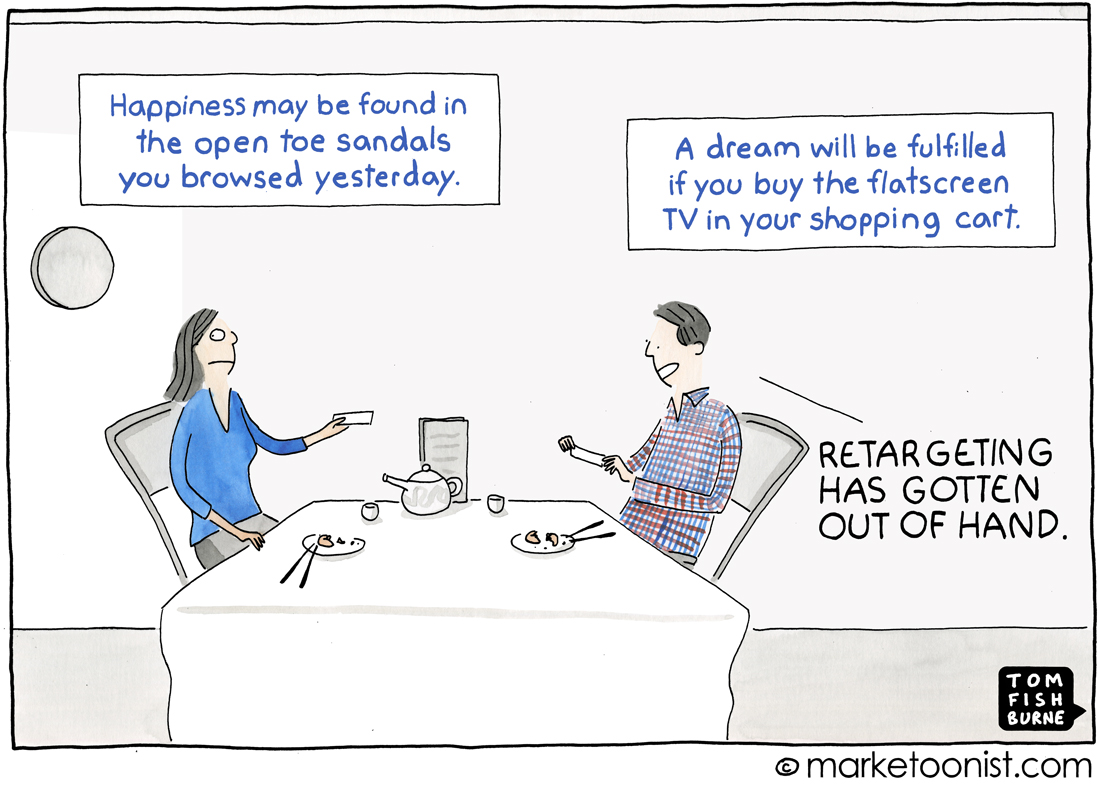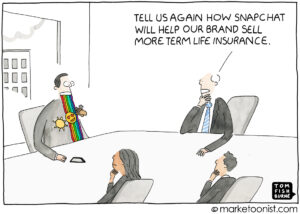If you think the way that retargeting ads follow consumers around the internet is a little creepy, just wait. Retargeting is only getting warmed up.
We’re all used to seeing ads for products that we’ve browsed online suddenly pop up ad infinitim on every other site we visit. Retargeting ads are 76% more likely to be clicked than regular display ads. But advertisers are increasingly able to use behavior in one channel to drive a marketing message in another.
No longer limited to siloes, retargeting increasingly spans desktop, mobile, and apps. There is even some retargeting experimentation integrating mobile with offline out-of-home billboards.
Anheuser-Busch InBev started using geofencing techniques to serve certain mobile ads to consumers who recently drove by one of their billboards.
General Motors ran a Chevy Malibu billboard ad on a highway west of Chicago that triggered based on the specific cars driving by. Cameras flagged which car was approaching and then customized a marketing message comparing that car with Chevy Malibu. For example: “The Malibu has more available safety features than your Hyundai Sonata.”
While GM stresses that these billboards are not collecting data, the momentum is there generally for marketers to integrate all of their offline and online data to create smarter advertising.
As exciting as the technology can seem, marketers need to be aware there’s a cool-to-creepy spectrum in retargeting. On the cool end, it can lead to ads that are more relevant and contextually aware. On the creepy end, it can come across as intrusive.
I’d love to hear your thoughts on where advertisers should find the right place on that spectrum.
Here’s a related cartoon from 2013 on the dystopian potential of retargeting.




ASIT GUPTA says
Instead of getting better and better at TARGETTING and marketing@ consumers, if marketers were to spend even a fraction of time and money marketing with consumers, everyone will be happier, including the CFO. The solution to everything seems to be a piece pf brand content laser targetted. Put some magic back into the product, get your existing users to talk about it honestly and keep at that program for years and not as a 1 off campaign. Over a period of time you will have 1000s of active advocates who will together give you more targetted (and more importantly) trusted reach, than for sale influencer or paid media.
Jacqueline Drew says
Love how your panel cartoons make the point. I am with Gupta on this. I think it’s creepy because it’s unintentionally creating a personal relationship with a robot, that’s following you everywhere. Perhaps business needs to get back to basics, actually keeping staff who build and maintain those personal relationships instead of using retargeting so much. Retargeting has a great risk of creating offense to customers. Perhaps it will be regulated in future (or companies my voluntarily do this); i.e. Ask customers for permission- would you like to be reminded to revisit us in the future? If so, when? Kind of like opting in to spam instead of making the assumption. By the way, I loved your daughter’s Ted Talk! I’m a mom too, and it made my eyes water! You must be so proud!
Ben Baker says
Tom, as a marketer, I get retargeting. . Not sure I like how far it has progressed on the creepy scale but I get it. .
My challenge is that today people are so focused on digital analytics that they fail to confirm their findings with real world champions on their brand. . Is it easier and more efficient to gather data electronically and then rely on the interpretation of that data to move forward? YES. . . but I would say that it far less accurate than taking the time to find out face to face what your true customers want and feel about your product.
Ben
Allen Roberts says
If right, and I am sure you are, these developments will give a massive kick-along to ad blocking tech and use.
Ben Baker says
I am there 100% with you with Ad Blocking. It is my favourite app on my computer!
Shane Cox says
I agree that the following me around and constantly showing me ads is creepy. It’s almost like stalking. However, I am building an app that will be more favorable. Although it will not follow you around showing you ads. It will send you ads from your favorite stores to let you know about the best sales. It will also change as you walk into any store that is within the network so that it looks like the stores app. Showing you what is on sale at the moment. This will be controlled by the store. It will also give you menus, product locations within the store to save you time, etc. However, you will not receive an ad from a store that you haven’t visited.
This app is truly the Last re-marketing app that anyone will ever need. Like having an assistant in your phone that will alert you to the sales and where to look for products that you are searching for. There is even a part of the app that will suggest products based on what you already have in your shopping cart. Just wanted to let you know what is coming. Less creepy, more practical and better for the user and the business.